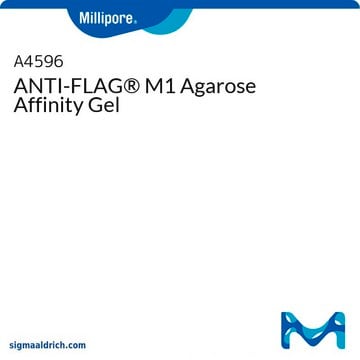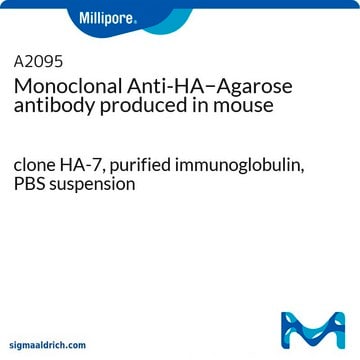11815024001
Roche
Anti-Protein C Affinity Matrix
from mouse IgG1κ
Sinonimo/i:
affinity matrix, anti-protein c
About This Item
Prodotti consigliati
Origine biologica
mouse
Livello qualitativo
Coniugato
agarose conjugate
Forma dell’anticorpo
purified immunoglobulin
Clone
HPC4, monoclonal
Forma fisica
slurry
Confezionamento
pkg of 1 mL (settled resin volume)
Produttore/marchio commerciale
Roche
Isotipo
IgG1, kappa
Capacità
2-10 nmol/mL binding capacity
Temperatura di conservazione
2-8°C
Descrizione generale
- Insertion of the protein C tag does not introduce a new metal-ion binding site. The antibody contains the Ca2+ binding site.
- Protein C tag can be integrated either at the N-terminus, C-terminus or internally without any change in antibody specificity.
- Rapid immunoaffinity purification under non-denaturing conditions using economical calcium chelating agent (e.g., EDTA) or alternatively a specific protein C-tag peptide.
Monoclonal mouse antibody Anti-Protein C (clone HPC4) is covalently coupled to agarose beads. In the coupling reaction 4mg of antibody is reacted per 1ml of beads.
Specificità
Applicazioni
- Immunoprecipitation of Protein C-tagged proteins from mammalian, bacterial, and yeast cell extracts
- Affinity column purification of Protein C-tagged proteins from crude protein extracts
Following immunoprecipitation or purification, the tagged protein of interest may be analyzed by:
- Western blotting using the Anti-Protein C antibody
- Silver staining (or similar protein stain)
Caratteristiche e vantaggi
- use gentle elution conditions using calcium-chelating agents like EDTA.
- highly specific to EDQVDPRLIDGK, derived from protein C.
- binding of Anti-Protein C to protein C-epitop is dependent on the presence of calcium ions.
- suitable for purification of proteins containing protein C as N-terminal, C-terminal or internal fusion.
- applicable with crued cell extracts from mammalian, bacterial, and yeast expression systems.
Contents
1. The antibody is covalently coupled to agarose beads and supplied as a 2ml slurry containing 1ml beads and 1ml buffer.
2. 4mg of antibody is reacted per ml of beads in the coupling reaction.
3. A plastic column with top and bottom caps is included.
Confezionamento
Qualità
Stato fisico
Risultati analitici
Altre note
Codice della classe di stoccaggio
12 - Non Combustible Liquids
Classe di pericolosità dell'acqua (WGK)
WGK 1
Punto d’infiammabilità (°F)
does not flash
Punto d’infiammabilità (°C)
does not flash
Certificati d'analisi (COA)
Cerca il Certificati d'analisi (COA) digitando il numero di lotto/batch corrispondente. I numeri di lotto o di batch sono stampati sull'etichetta dei prodotti dopo la parola ‘Lotto’ o ‘Batch’.
Possiedi già questo prodotto?
I documenti relativi ai prodotti acquistati recentemente sono disponibili nell’Archivio dei documenti.
Il team dei nostri ricercatori vanta grande esperienza in tutte le aree della ricerca quali Life Science, scienza dei materiali, sintesi chimica, cromatografia, discipline analitiche, ecc..
Contatta l'Assistenza Tecnica.








